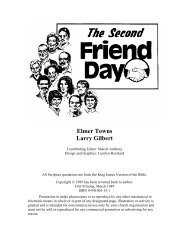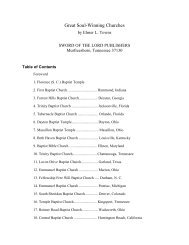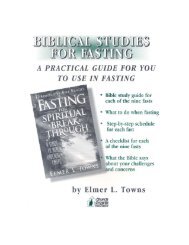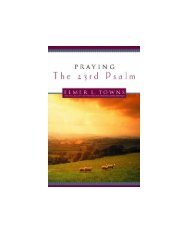Ministering to the Young Single Adult - Elmer Towns
Ministering to the Young Single Adult - Elmer Towns
Ministering to the Young Single Adult - Elmer Towns
You also want an ePaper? Increase the reach of your titles
YUMPU automatically turns print PDFs into web optimized ePapers that Google loves.
IntroductionFive years ago this book appeared in print because I could find no written helpdealing with young single adults in <strong>the</strong> church. Since that time Christian journalism hasbeen giving some help (see bibliography). Those wishing <strong>to</strong> minister <strong>to</strong> <strong>the</strong> young singleadult on a personal basis or as a group will find help.Time magazine named as man of <strong>the</strong> year <strong>the</strong> young single adult, “<strong>the</strong> man andwoman 25 and under,” focusing national attention on <strong>the</strong> swingers. Apartment complexeshave been built for <strong>the</strong>m, bachelor <strong>to</strong>urs planned for <strong>the</strong>m, and movies made about <strong>the</strong>m.However, not all <strong>the</strong> young single adults fit that formula.The 1950s witnessed a trend <strong>to</strong> earlier marriages, stampeding journalists in<strong>to</strong> printagainst “teenage marriages.” Now, <strong>the</strong> trend is reversed and couples are getting marriedlater in life. Late marriages, coupled with exploding population, results in more youngsingle adults. The church should be more concerned about <strong>the</strong>m than ever before.I studied fifteen young single adult groups in churches before writing <strong>the</strong> originalvolume. Since that time I have visited ano<strong>the</strong>r twenty-five groups, and am encouragedthat <strong>the</strong>re is a ministry <strong>to</strong> <strong>the</strong> young single adult at <strong>the</strong> local church level. The followingprinciples should be added, growing out of my observations in <strong>the</strong> past five years.1. Small churches with less than five young adults should not plan an organizedmeeting for <strong>the</strong>m. If <strong>the</strong>re are a few young single adults in a church, involve <strong>the</strong>m inservice especially in <strong>the</strong> Sunday School, club programs and service areas of <strong>the</strong> church.The environment in small churches usually accentuates “singleness” among <strong>the</strong>unmarried, because <strong>the</strong> social life of <strong>the</strong> church is directed <strong>to</strong>ward a family orientedministry. Leaders in small churches who have young single adults should encourage <strong>the</strong>m<strong>to</strong> attend fellowships for singles in o<strong>the</strong>r churches or provide a fellowship meeting on aninter-church basis.2. If a new work with young single adults is not successful within two months, itshould be dropped. Because of <strong>the</strong>ir drive for fellowship, arising from loneliness andidentity-crisis, young single adults go where <strong>the</strong>re is warmth and opportunities <strong>to</strong> mee<strong>to</strong><strong>the</strong>r adults in meaningful settings. When new works are begun, and young single adultsdo not attend, perhaps non-verbal messages of “manipulation” are communicated,offending <strong>the</strong> young single adults. They do not want <strong>to</strong> be treated as special cases, ra<strong>the</strong>ras human beings. Some churches patronize <strong>the</strong>m, hence driving <strong>the</strong> visi<strong>to</strong>r away. Thosesingle adults who already come will <strong>to</strong>lerate <strong>the</strong> patronization and continue attending andserving. But <strong>the</strong> <strong>to</strong>tal environment in <strong>the</strong> church will not attract o<strong>the</strong>r young single adults.3. College and career classes do not mix. Most large churches have a college andcareer Sunday School class, but this method of organizing a class contradicts <strong>the</strong> natureof <strong>the</strong> two groups. The career single adult wants more fellowship, more activity, andmore involvement. At <strong>the</strong> same time, <strong>the</strong> college student is involved in studies, classes,sports events and organized institutional life, i.e., <strong>the</strong> college. As a result, <strong>the</strong> careeradults plan <strong>the</strong>ir meetings around activity and involvement, hence attracting o<strong>the</strong>r career
















